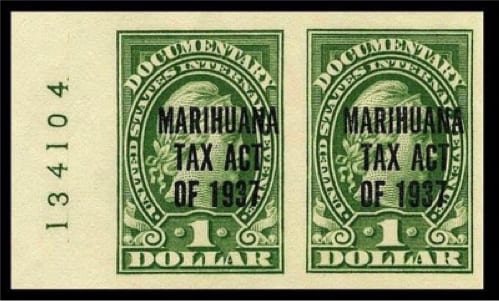The Marihuana Tax Act of 1937



It was the 1930’s, the decade that invented the future; it was also the decade that the Great Depression started in the United States. Television was beginning to gain momentum.

Ruth Wakefield at the Toll House Inn in Whitman, Massachusetts, made the first batch of Toll House cookies.

Mahatma Gandhi started his 200 mile march to Jalalpur to protest British Rule, and Orson Welles directed and narrated “The War of the Worlds”, a simulated newscast of a Martian invasion.

Many after listening to the broadcast panicked, believing the invasion was real. Listeners who tuned in during the show didn’t know if the broadcast was fact or fiction. Like Orson Welles’ radio show many people were stunned and panicked with the 1937 when President Franklin Roosevelt signed the Marihuana Tax Act of 1937, a tax stamp required for legal import and export of the drug.

Since 1902, Popular Mechanics, founded by Henry H. Windsor, became America's top monthly magazine, publishing articles on home improvement and automobile maintenance and on new advancements in technology and science.
Eleven years after the Marihuana Tax Act, in 1948, Sammy E. Pierce was born in Keokuk, Iowa, near the confluence of the Des Moines and Mississippi rivers.
The ravaging effects of the World War II and Depression had taken its toll on the United States.
As a young boy, Sammy saw first hand the transition from an agricultural economy to a mixed economy as a result of The Great Depression and World War II. These events accelerated the shift away from small family farms to larger industrial farms. Sammy was the human version of Popular Mechanics. His goals and visions were like magazine articles from home, farm improvements to automobile combustion fuels to new improvements in technology, and the sciences.
During World War II, Sammy witnessed a particular increase in manufacturing operations. Agriculture was the state's dominant industry; Iowans also produced a wide variety of products, including refrigerators, washing machines, fountain pens, farm implements, and food products.
Sammy's keen interest was in a thing called Vertical Integration. According to the American Journal of Agricultural Economics and Oxford Academic:
“Vertical integration (VI) is defined as the ownership of the production of a previously purchased input used in the manufacture of output or the property of a production unit that previously had purchased the output from a particular firm.”
Or, simply put, Vertical Integration is a strategy by which a company integrates all the components of their production, wherein each step "feeds into" the next, creating increased efficiencies.
The United States was recovering from the Great Depression and WWII. While in high school, Sammy's interest was in the sciences. An ambitious young man, Sammy took his science projects to the State Science Fair, and he received a First Place Award. (His winning project was the creation of a biofuel from algae, which he then demonstrated by using this fuel to fly a model airplane around the school gymnasium...)
Sammy was always an entrepreneur, an inventor, and a scientist.
His passion was in the development and application of technology in the fields of energy, agriculture, and the food industry.
While attending High School in Mississippi, Sammy was intrigued by an old 1938 publication in Popular Mechanics, "New Billion-Dollar Crop." Ironically, the article was published a few months after the passage of the new marijuana tax act. The Popular Mechanics magazine article on hemp was on the tremendous potential of the entire hemp crop titled "New Billion-Dollar Crop." What interested Sammy was that hemp could be used to make multiple products. In 1937, hemp could be used to produce 5,000 textile products, and more than in 25,000 other products.



One person Sammy looked up to while a student was Dr. Norman E. Borlaug, a, a world renown agronomist, who led initiatives worldwide that contributed to the significant increases in agricultural production, termed the "Green Revolution". Borlaug received multiple honors for his work, including the Nobel Peace Prize, the Presidential Medal of Freedom, the Congressional Gold Medal, and was knighted by Queen Elizabeth.
Borlaug is an American hero, known for saving the lives of 1 billion people from death by starvation. Dr. Borlaug is credited with the scientific revolution in agriculture and known to have brought human peace and progress through vertical integration of crop production. Borlaug, who was seen as a real humanitarian and agronomist, helped provide bread and food for a hungry world. Dr. Borlaug is credited with saving more lives than any other person - ever.
Through the years, Sammy has looked at Dr. Borlaug's application of vertical integration in saving the lives of 1 billion people from death by starvation. Sammy's hard work, patents, and inventions were done to save the lives of the people on this planet.
So what happened to the "New Billion-Dollar Crop"? What curtailed Cannabis' Billion Dollar potential?
The Marihuana Tax Act of 1937 was originally passed to levy taxes on cannabis/hemp products and the commercial sales of cannabis-based products. The farmers in the United States could obtain tax stamps for the farming of fiber hemp.
Physicians looking to add the health benefits from cannabis were required to pay the Marihuana Tax for prescribing and selling cannabis.
With the restrictive legislation, taxes, and other burdens imposed on cannabis, the "New Billion-Dollar Crop" vanished as the source for 25,000 products.
The main crisis concerning hemp arose in America during the 1930s due to propaganda created from companies with a vested interest in the new petroleum-based synthetic textile companies. The large and powerful newspaper/lumber barons also saw hemp as a big threat to their businesses. In the 1930s, DuPont patented a new petroleum based “plastic fiber,” and wanted to do away with hemp products. Don't-cha just love politics...?



After The Marihuana Tax Act of 1937, hemp and it’s production was further depicted as an evil, and banned altogether. Along with this ban, The Canadian government, following the American lead, prohibited production under their Opium and Narcotics Act on August 1, 1938.
As the result of 1930s politics, no one was allowed to cultivate or even do research on cannabis/Hemp. Even though Sammy was intrigued by hemp’s 25,000 products, he had to turn his attention to other crops and potential that lead to new discoveries and patents. The first U.S. Patent on Diesel Fuel by Fermentation of wastes (No. 4,369,056 on Jan. 11, 1983), co-patented by Sammy and Professor Morris Wayman, a Canadian chemist. This motivated Sammy to trade mark the name 'Bio-Diesel' with U.S. Trademark: Bio-Diesel Jan 1, 1985 No 1,311,911
Sammy dedicated his life to bio-fuels research, beginning in high school where he participated in the high school science fair projects in bio-energy and won the high school Grand science fair producing biofuels and hydrogen from algae for lunar colonization. Sammy was also a National Merit Science winner (The top ½ percent of students nation wide.)
In 1980, after co-inventing “Bio-Diesel Fuel”, Mr. Pierce founded one of the oldest bio-fuels research companies in the U.S. He raised over $20 million to sponsor biofuels research at the University of Toronto, Truman State University Medical School, the University of Missouri at Columbia, Texas A&M University, the Woods Hole Oceanographic Institute (Dept. of Navy), Oak Ridge National Laboratories, Illinois State, Louisiana State, Ohio State, Oregon State Universities. His biofuels research has been featured in National Gasohol Magazine, Mother Earth News, High Technology Magazine, Mayors Weekly, Engineering News, Food Engineering, Food Product Design, and the United Nation's world Encyclopedia of Life Support Systems: UNESCO EOLSS-- “The Next Generation in Bio-Fuels: The Mini Bio-Fuel Refinery”—see www.eolss.com/energenetics.
The connection of hemp as a crop and marijuana seems to have become exaggerated. The THC-laden drug is usually produced from wild hemp or "locoweed", which can be found on vacant lots and along railroad tracks in every state (aka "Ditch Weed"). If federal regulations can be configured to protect the public without preventing the legitimate cultivation of hemp, this 'new' crop can add immeasurably to American agriculture and industry.
With new patents and discoveries, where do we go from here? Fast forward 81 years: had cannabis/hemp remained legal since 1937, the farmers and scientists would have continued with the "New Billion-Dollar Crop"; the discoveries and technologies on this feedstock would have kept growing every year. The conclusions of the article in 1937 Popular Mechanics highlighting cannabis/hemp, -if adjusted for inflation and no other technologies or discoveries were discovered on cannabis after 1937 - $1,000,000,000.00 then would equal over $1.75 trillion in 2020. The average annual inflation over this period was 3.57%. (Check it out yourself; the link to the SEC calculator is: https://www.investor.gov/financial-tools-calculators/calculators/compound-interest-calculator)
It's 2021 and the HBR is utilizing the enormous potential of Cannabis Hemp supports the 1937 Popular Mechanics: Hemp "New Billion-Dollar Crop.” it's ”Back to the Future.”
Looking back at what could have been, I sat down, grabbed a glass of milk with a plate of Ruth Wakefield Toll House cookies, and wonder, will 2020 be the decade that invents the future with cannabis hemp? What advances could have been made on hemp if the 1938 Popular Mechanics: Hemp "New Billion-Dollar Crop" was never made illegal. If we were to implement the Hemp-BioRefineries technologies in 2020, we could reinvent the future and bring back the "New and improved Multi-Billion-Dollar Crop.”



Sammy Pierce tracked me down in 1988 after I built a few microbreweries and wanted me to down-size an ethanol plant, replacing the alcohol fermentation with butanol. With my help, Sammy went about inventing and engineering a microbrewery into a vertically integrated Community Bio-Refinery (CBR). At the time he was describing what he wanted to accomplish, the 1985 American science fiction film ”Back to the Future” was three years old.
Our meeting that day reminded me of the conversation Dr. Emmett (Doc) Brown had with Marty McFly. When Sammy described his vision of a CBR to me it was like a Doc Brown explaining what a Flux Capacitor is. I listened to him describe the mill, auger and fermentation tanks I installed in breweries in relation to a bioreactor.
I understood what he was saying, but all I could think was
”If my calculations are correct, when this baby hits eighty-eight miles per hour... you're gonna see some serious sh**.”
As I sat back and grabed an ice-cold glass of milk with a plate of Ruth Wakefield Toll House cookies, I wonder what advances could have been made if the 1938 Popular Mechanics: Hemp "New Billion-Dollar Crop" was never made illegal. If we were to implement the Hemp-BioRefineries technologies in 2020, we could reinvent the future and bring back the "New and improved Multi-Billion-Dollar Crop.”
We are not "Outatime"
Ah... Are you telling me that you engineered a fermenter into a bioreactor?
I kept hearing Marty’s question to Doc,
Wait a minute, Doc. Ah... Are you telling me that you built a time machine... out of a DeLorean?
I was totally enthralled with Sammy’s CBR vision, and like Doc, I waited for him to say
”If my calculations are correct, when this baby hits eighty-eight miles per hour... you're gonna see some serious sh**.”
As I sat back and grabed an ice-cold glass of milk with a plate of Ruth Wakefield Toll House cookies, I wonder what advances could have been made if the 1938 Popular Mechanics: Hemp "New Billion-Dollar Crop" was never made illegal. If we were to implement the Hemp-BioRefineries technologies in 2020, we could reinvent the future and bring back the "New and improved Multi-Billion-Dollar Crop.
"We are not "Outatime“
